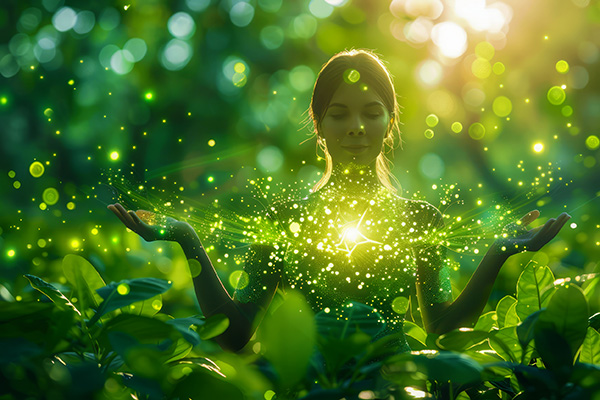nutrition
Staying Spiritually Nourished In A Digital World
 If you’re feeling stuck in cycles of anger, sadness, anxiety, or fatigue, take a moment to ask yourself: what am I consuming?
If you’re feeling stuck in cycles of anger, sadness, anxiety, or fatigue, take a moment to ask yourself: what am I consuming?
This question goes far beyond food. Are you consuming negativity online? Are you surrounding yourself with people who drain rather than uplift? Are you spending more time in front of a screen than under the sky?
Everything you consume and engage with in this world either feeds your inner light or diminishes it. Everything you watch, listen to, interact with, and invite into your life.
This truth is simple yet profound. We may not always realize it, but the choices we make each day either nourish our spirit or cloud it.
In today’s world, it’s easy to become entangled in habits, distractions, and energies that gradually drain our vitality. The barrage of social media updates, the constant hum of technology, processed foods, fear-driven news cycles, anger, jealousy, dishonesty, and gossip. All of these things can chip away at the divine light within us, if we let it.
On the other hand, there are sacred and intentional choices that can uplift and energize us. Fresh fruits and vegetables grown with love from the Earth. Gentle sunlight warming your skin. Time in nature, listening to the rhythm of the trees and the whispers of the wind.
Loving and conscious relationships. Forgiveness. Kindness. Generosity. Dance, art, singing, and the tender beauty of genuine joy. These are not luxuries. They are lifelines to your highest self. They feed your light. Continue reading
Nurture Your Body To Boost Your Spirit
 When we think of spiritual practices, we generally focus on activities like meditation, prayer, energy healing, or divination.
When we think of spiritual practices, we generally focus on activities like meditation, prayer, energy healing, or divination.
While these are all important, we sometimes overlook a crucial pillar of our spiritual groth and well-being: caring for our physical body.
The body that carries us through life is sacred. The familiar phrase, “My body is my temple,” contains a profound truth.
When we treat our body with love, intention, and reverence, it naturally supports the expansion of our spiritual awareness and soul evolution.
Our body is how we experience the world. It’s easy to overvalue the mind alone, but the brain is also part of the physical body.
Without nurturing our physical well-being, our cognitive and intuitive functions can falter. The clearer and more vital our physical state, the more clarity and depth we bring to every level of our consciousness.
At some point on our spiritual path, we are called to care deeply for our physical body. What this looks like varies from person to person. Of course, if you’re dealing with any health concerns, it’s essential to see a qualified healthcare provider.
However, you don’t need to overhaul your life to get started. You can start by attending to your physical wellness with simple changes like drinking more water, moving your body daily, limiting screen time, enjoying time in nature, and choosing nourishing foods.
The Power Of Knowing Your ‘Why’
 In a recent spiritual counseling session, I had the privilege of working with a woman who was facing a profound life challenge — stage 2 locally advanced colon cancer.
In a recent spiritual counseling session, I had the privilege of working with a woman who was facing a profound life challenge — stage 2 locally advanced colon cancer.
She spoke with a quiet resilience as she recounted her journey through chemotherapy before surgery, followed by four additional rounds of adjuvant chemotherapy.
There was little emotion in her words, but the weight of her experience was undeniable. It was a story of survival, perseverance, and the sheer will to move forward.
She then admitted that she longed to live a healthier lifestyle, but struggled with unhealthy eating habits. She had gained a significant amount of weight after her surgery, and despite her best intentions, she found it difficult to resist sweets and processed foods.
After hearing her story, I gently reminded her that I could not give her medical advice. Nor am I a nutritionist, and I advised her that professional guidance was essential for her dietary needs.
What I could offer, however, was a way to break the cycle of unhealthy habits. And I could help nurture her mind and emotions and guide her toward a life of greater wholeness and balance.
She lit up with hope. “That would be wonderful!” she exclaimed.
Is It Time To Reset Your Life?
 As the festivities fade and the hype of new year’s resolutions subsides, it’s natural to pause and truly reflect on the direction of your life.
As the festivities fade and the hype of new year’s resolutions subsides, it’s natural to pause and truly reflect on the direction of your life.
Often idealized as a time of joy and connection, the holidays rarely leave room for true introspection. Instead, they bring a whirlwind of obligations — shopping, entertaining, traveling, and endless social engagements. In the rush to meet expectations, both our own and those of others, the peace and reflection we crave are often drowned out by the festive chaos.
But as the holidays end and life returns to its normal routine, many feel a spontaneous urge to make an honest assessment of where they are in life. What’s working? What isn’t? Where do adjustments need to be made?
In the hustle and bustle of everyday life, it’s easy to lose sight of our true passions and purpose. Often we carry unnecessary burdens, cling to outdated habits, or stay in situations that no longer align with our higher selves.
Now is often the time of the year when your intuition may be whispering — or even screaming — that something needs to change. This inner knowing often manifests as dissatisfaction, a longing for something more, or a deep sense that you’re meant for greater things.
Recognizing the need to reset your life can be one of the most empowering decisions you’ll ever make. Letting go of what no longer serves you is not only a courageous act, but also a fundamental aspect of personal and spiritual growth.
The Ancient Art Of Facial Reading
 Physiognomy is an ancient belief system that the face reveals the hidden truths of the mind, body, and spirit. In many cultures, the face is seen as a reflection of the soul or inner self.
Physiognomy is an ancient belief system that the face reveals the hidden truths of the mind, body, and spirit. In many cultures, the face is seen as a reflection of the soul or inner self.
This belief that a person’s physical characteristics, such as the shape of their face, eyes, or nose, can reveal something about their inner nature has roots in various ancient cultures and has been practiced for thousands of years. In some esoteric traditions, facial characteristics are believed to also reveal past life influences and karmic imprints.
The face is more than just a reflection of our emotions; it is a map of our physical health, life experiences, and even our spiritual state. By observing our facial features and learning to interpret their subtle messages, we can gain valuable insights into our health and well-being.
One of the earliest and most detailed systems of face reading comes from Traditional Chinese Medicine (TCM). Chinese face reading, or Mian Xiang, dates back more than 3,000 years. Practitioners view the human face as a map of a person’s life, health, and destiny. They divide the face into different areas, each corresponding to different internal organs and emotional states. Facial analysis is used to diagnose imbalances in the body and mind.
Physiognomy was also practiced in ancient Greece. The philosopher Aristotle (384-322 BC) wrote about it, arguing that certain facial features could indicate personality traits and that there was a connection between a person’s appearance and their character. Greek scholars believed that external features, such as facial structure, could provide insight into a person’s moral and psychological makeup.
Tarot Forecast September 2024: Two Of Cups
 The card that came up for this month is the Two of Cups, which carries the symbolism of connection, balance, harmony, mutual affection, and partnership.
The card that came up for this month is the Two of Cups, which carries the symbolism of connection, balance, harmony, mutual affection, and partnership.
In the Rider-Waite Tarot deck, this card depicts a couple standing face to face, each holding a golden cup in one hand. They extend their cups toward each other as if in a toast or exchange, symbolizing a mutual offering of affection, love, support, or a celebration of their shared success. Their gaze is locked, indicating a deep connection and understanding between them.
Above their heads is a caduceus, the ancient symbol of healing, two serpents intertwined, representing their powerful union and the personal and spiritual healing they find with each other. At the top is a winged lion’s head, symbolizing spiritual strength and divine protection in the sacred union of their souls.
The core meaning of this card is the coming together of two individuals. This can be romantic, platonic, or business-related. The emphasis is on mutual respect, harmony, understanding, and a balanced give and take.
The cups also represent emotion. It’s a card of deep emotional intimacy, connection, and a harmonious union based on mutual respect and love. This card often signifies the beginning of a new chapter in a partnership or committed relationship, full of potential and growth.
As we enter this new month, the energy of the Two of Cups will take center stage, guiding us through various aspects of life with themes of harmony, emotional connection and mutual understanding.
